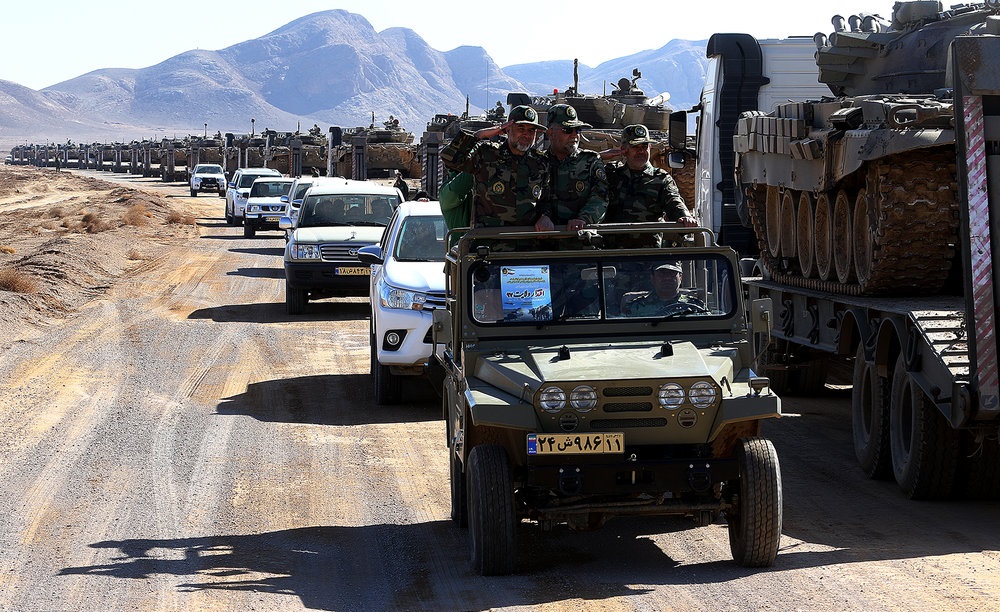Iranian ground forces recently concluded two-day drills in the central province of Isfahan, held from January 25-26, to practice modern combat tactics that are said to be in compliance with new structural changes to Iran’s army.
The annual large-scale drills, dubbed Eghtedar-e-97 (meaning “authority 97” in Farsi) took place in a public area of Nasrabad, located in Isfahan province in central Iran. Over 12,000 soldiers from the Army Ground Force demonstrated a variety of assault operations, unified assault, and clean-up using rapid reaction forces.
Armored units, artillery, rapid response, mechanized infantry, martial engineering, telecommunications, and airborne, UAVs and Airborne units, with the support of Army Air Force fighters, all participated in the drills. Two changes of approach pertaining to mobility and invasion were also assessed.
During one particular exercise, Iran’s army practiced a tactic to prevent the enemy from closing in on the battlefield by creating a long row of blasts using remote-controlled land bombs. Engineering units had been deployed to the drill zone 10 days in advance of the exercise to design and prepare the line of explosion and plant remote-controlled bombs.
“During the first stage of the last day of the drills, which kicked off on Friday, the portable and stable artilleries targeted enemies' positions in 10-30 km distances with precision-guided and intelligent shells,” the spokesman for Eghtedar-e- 97, Brigadier General Nouzar Nemati, said according to IRNA.
In the first stage, following reconnaissance Mohajer drones and R-4 helicopters, the 55th Airborne Brigade and the rapid reaction Brigade 25 – all fully-equipped – entered the region by helicopter. They proceeded to identify, clear and destroy the enemy's elements, equipment and fortifications. The heliborne operation was implemented by heavy-lift Chinook helicopters and Bell-214 helicopters.
“During the second stage, the infantry and armored units annihilated enemies' positions by conducting offensive operation,” Nemati said.
During the final stage of the drills on January 26, combat engineers created a line of explosion six kilometers long to block the forward movement of the mock enemy’s personnel carriers and armored vehicles.
The Iranian Army has intensified military exercises since May of last year, when tensions between the United States and Iran rose to new heights and following President Donald Trump pulling the U.S. out from the nuclear deal. By conducting military exercises, Iran tries to showcase its military readiness and capabilities as well as its missile power. Iran has repeatedly vowed to respond strongly to any attack by Israel or the U.S., both which see Iran as a menace in the Middle East region.
Earlier this month, Iran’s air force conducted massive aerial drills codenamed Modafean-e-Aseman-e-Velayat 97 (“the Defenders of Velayat Skies 97), also held in Isfahan. That exercises made use of Iran’s Sukhoi Su-24, F-4 and F-7 Phantoms; MiG-29, F-14 jets, Boeing 707 and 7047 aerial refueling planes, as well as C-130 Hercules transport aircraft and drones equipped with precision strike missiles and long-range smart bombs.







 Russian peacekeeping forces, deployed in the Karabakh (Garabagh) region of Azerbaijan since 2020, have commenced their withdrawal from the area.
Russian peacekeeping forces, deployed in the Karabakh (Garabagh) region of Azerbaijan since 2020, have commenced their withdrawal from the area.
 The number of evacuees from flooded areas in Kazakhstan has reached 97,852 people, including about 32,856 children since March 27.
The number of evacuees from flooded areas in Kazakhstan has reached 97,852 people, including about 32,856 children since March 27.
 The Islamic holy month of fasting, Ramadan comes to an end this week with the celebration of a joyous festival called Eid (meaning “festival” in Ar...
The Islamic holy month of fasting, Ramadan comes to an end this week with the celebration of a joyous festival called Eid (meaning “festival” in Ar...
 Azerbaijan officially unveiled the logo for the upcoming 29th session of the Conference of the Parties to the United Nations Framework Convention o...
Azerbaijan officially unveiled the logo for the upcoming 29th session of the Conference of the Parties to the United Nations Framework Convention o...



